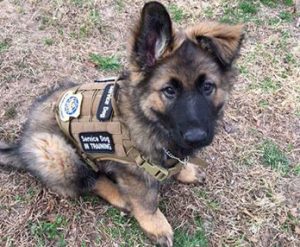Frequently Asked Questions
The cost of the service dog to a veteran is free. We will also provide vests, training equipment, kennels, food and veterinary costs if the veteran is in need.
K9s For Camo does not train service dogs for the public. If you would like a trained service dog, you can contact Howliday Inn Pet Resort and discuss your needs.
All training consists of a lot of repetition and reinforcement and times can vary. Diabetic alert training takes the longest, due to all the variables involved. Read more about the tasks service dogs perform.
Training time varies with each dog, as well as the scope and degree of difficulty of the complement of tasks needed to support a specific veteran. Advanced tasks, i.e. diabetic alert, can take much longer than some of the more basic tasks. On average, our K9s train for 6 months before being paired with their veteran. Once matched, the veteran/K9 team continue training classes for several weeks to learn to work as a team and hone task skills. Learn more about the training process.
Approximately 75% of dogs who begin K9 Boot Camp training at the Ozark Correctional Center complete the program. We are constantly testing service dogs candidates; of the dogs we evaluate, only about 10% are admitted to K9 Boot Camp.
We place dogs rejected from training in homes or return them to the rescue group from which they came. The rescue groups with which we work are “no-kill” shelters that use fosters who help place the dogs as well. The shelter dogs receive some obedience training and socialization work even as they are evaluated, which increases their likelihood of being adopted quickly. Those who are rejected later in the training process are usually highly desirable candidates for adoption.
Most veterans choose to keep their retired service dogs as pets when they retire. If not, or they are unable to for other reasons, we help find a forever home for the K9 to enjoy retirement.
We use all breeds – we are not breed specific. We look for a special temperament and personality for our program, and can find that in any breed.
Service dogs are trained to perform tasks to support their human partner and are granted access and privileges by the Americans with Disabilities Act (ADA). Therapy dogs and emotional support animals (ESAs) are not covered by the ADA and do not have the same access and privileges as service dogs. Therapy dogs help other people. They go to schools, hospitals, etc., to cheer people up. ESA”s must be prescribed by a licensed medical professional and support their human via their companionship and comfort. Read more information about service dogs, therapy dogs and ESAs.
If the veteran cannot keep the service dog, we will take the dog back and retrain the K9 to team with another veteran. If something happens to the veteran, the veteran’s family may choose to have the K9 remain with them – we do not want to separate families. If not, depending on the dog’s age, we will either retrain the K9 to team with another veteran, or find a forever home for retirement.
We like to start training with dogs who are between the ages of 6 months and 3 years.
All the dogs are trained on a core set of tasks and obedience skills. As we identify which veteran the K9 will best match, we transition the task training of the K9 to fit the specific needs of the veteran. Read more about the tasks our K9s learn to perform.
We prefer to choose the dogs we train to ensure they have the correct temperament and aptitudes, maximizing the likelihood of success as a service dog. It is very rare that we train a family pet as a service dog. We can evaluate a family pet, but at the very minimum, they cannot display any of the following: aggression, fear, separation anxiety, issues with other dogs, extreme pulling on the leash, jumping on people or over-excitability. Also, a dog who is used to being a pet may have difficulty transitioning to being “on duty” as a service dog.



















